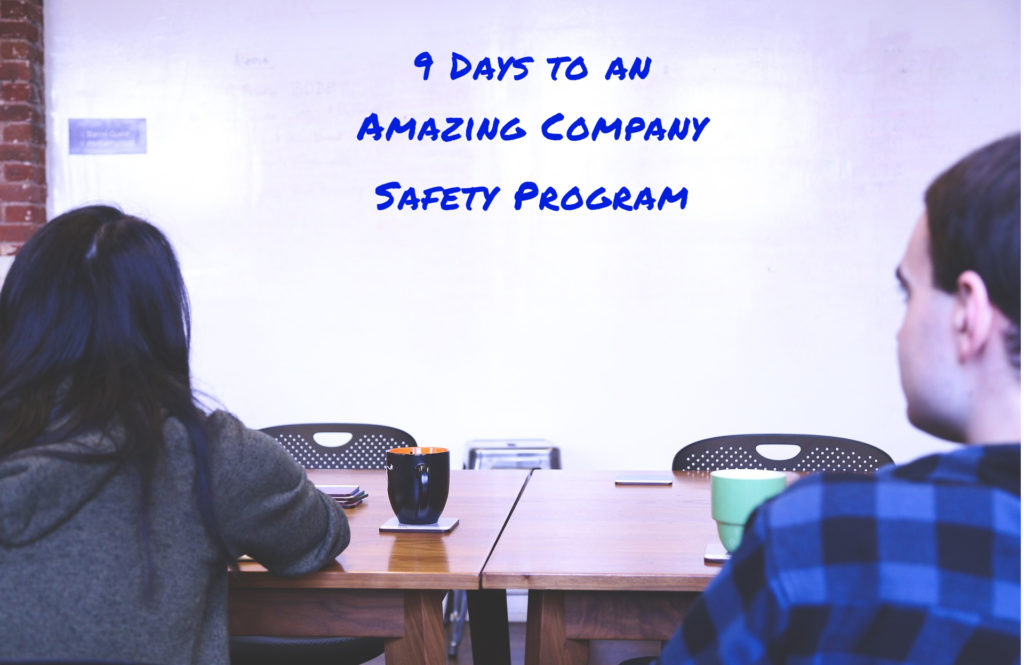9 Days To An Amazing Company Safety Program
Investing into your workplace is money well spent. Companies with effective and efficient safety programs receive many benefits including fewer workplace injuries and claims, improved company morale, and lower insurance premiums. In fact, well-developed safety policies and in-depth employee training will not only protect your investment and save you money in the long run, but it will also ensure that your company is around for years to come.
The question is, “How do you make an effective company safety program?” It doesn’t require months of planning or even weeks of work. You can develop an amazing and efficient safety program in just nine days.
Day 1: Commit to Safety
It might sound obvious, but the first step to your company’s safety is your commitment to it. Not only do your company’s executives need to be on board with a new safety program, but it should also rank highly with all managers and leaders. Management can then demonstrate their commitment to safety and instill that same commitment in their subordinates so that all employees follow the safety procedures.
Day 2: Set Your Safety Goals and Objectives
While it’s an important goal to “avoid all incidents” that goal is too broad to be effective for your company. Instead, you should develop specific goals and objectives based on your company and your employees.
This requires you to gather as much information as possible about the current conditions in your workplace. Commit to reviewing each job and taking it apart step-by-step in order to create goals/objectives around each.
Day 3: Determine Your Workplace Risks
You can’t develop a safety program if you don’t know your risks, hazards, and needs. The first key is to review your workplace and determine what areas, situations, and events have the potential to cause harm.
These are the risks that face you and your employees, and you are required to eliminate as much risk as possible to protect your employees.
You should break down the risks between:
Workplace these are hazards in the workplace such as layout, stairs, etc.
Activity: these are risks such as using heavy machinery.
Environmental: these hazards are related to things such as dust from heavy machinery use.
Day 4: Create a Written Plan
Once you’ve figured out where your risks are, the next step is to create a written plan/process that stipulates the safety requirements for every situation. By writing out your plan and requirements, you create an easy-to-read template that any employee and leader in your company can refer to and follow in any given situation.
Some commonly written plans include:
- Hazard communication program
- Personal protective equipment
- Emergency action plans
- Electrical safety
- Fire prevention plan
Day 5: Identify Your Workplace Training Needs
The key to any safety program is training. Your company’s safety policies are only as effective as your employees: the ones who will benefit most from a safe workplace.
The first step is to determine what type of training each employee requires. Based on your risk assessment and written plans, you should be able to determine the types of training courses that are required. If you’re not sure where to start, we recommend reviewing TriTech’s safety courses such as Standard First Aid, Confined Space Awareness, and Fall Protection for ideas.
Day 6: Create a Training Plan
Once you know what safety training you need, you need to set up a plan for training. Some courses can be completed once and last for three years. Other training may need to be more ongoing for the best results.
The key is to create a training plan that doesn’t disrupt your work environment. One way to do this is to schedule a private training session on-site to work with all your employees at once. Or you can schedule off-site training for each employee on a rotational basis so your work never stops but your employees are trained.
Day 7: Set Up a System of Checks and Balances
No matter how well trained your employees are they need a set of checks and balances to ensure that the safety rules and policies are being followed.
These checks and balances can be everything from creating a system to review hazard controls to ensure that none have failed and new hazards haven’t appeared to implementing a disciplinary system to punish employees who don’t follow the appropriate safe work procedures.
Day 8: Develop a Feedback System
An amazing company safety program has to be accepted by all of your employees. In fact, safety should be a condition of employment. Workplace safety is the responsibility of all personnel, so you need a system in place to receive feedback about the effectiveness of your program as well as ideas for improvement or modification.
This system should also allow you to recognize those employees that adhere to the program.
Day 9: Hire an Outside Expert to Review
Finally, once you have your safety program set up to a level where you feel comfortable, it’s important to bring in an outside expert for their opinion. This expert can help you review your safety processes for strengths and weaknesses, helping you look for a way to improve them. They can come in with a fresh eye to ensure that you’re following all safety policies as laid out by the government and to help you take corrective action.
Developing a company safety program is one of the best things you can do for your business. By taking the process one step at a time, you can ensure that nothing is forgotten and that the program is created and implemented in a timely manner, for the best results.
TriTech Safety & Training Inc, located in Grande Prairie is in the best position to keep you up-to-date with the essential and important industry practices for preventing avoidable accidents. For more information go to https://tritechsafety.ca/courses.





